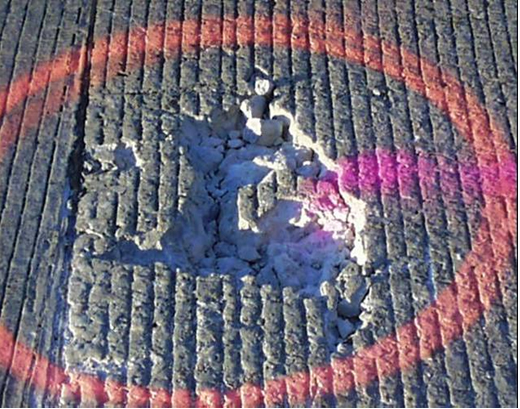2.2 Pavement Distress Types that Require Full-Depth Repair (FDR)
In concrete pavement contraction design (CPCD), the following distresses require FDR:
- transverse cracks,
- shattered slabs and corner breaks.
Transverse cracks that extend through the depth of a slab occur due to temperature/moisture variations and/or wheel load stress and require FDR. Transverse cracks in CPCD that extend through the depth of a slab are caused by design issues, such as inappropriate slab lengths and deficient slab thickness, or construction issues, such as non-uniform or insufficient base support.
Plastic shrinkage cracks occur when the rate of evaporation from the surface exceeds the rate at which the bleed water is available. Shallow plastic shrinkage cracks (approximately 1 to 2 in. from the surface) are not candidates for FDR unless they occur throughout the slab.
Shattered slabs and corner breaks in CPCD result from design issues, such as deficient slab thickness, or construction/design issues, such as non-uniform or insufficient base support.
In continuously reinforced concrete pavement (CRCP), the following distresses require FDR:
- punchouts,
- deep spalling.
Punchouts in CRCP are caused by design issues, such as deficient slab thickness, or construction/design issues, such as non-uniform or insufficient base support. It is manifested by depressed block(s) of concrete bordered by transverse and longitudinal cracks. Longitudinal steel crossing transverse cracks at the punchouts will eventually rupture, resulting in further deterioration of the punchout. Punchouts are the most serious distress type in CRCP. Improved design and construction practices by the department over the past several decades has significantly reduced the frequency of punchouts. Figure 10-1 shows a typical punchout. Note the asphalt patch was applied to restore the surface elevation, implying that the concrete block was pushed into the base or raveled out.

Figure 10-1. Typical punchout in CRCP.
Spalling is another distress type in CRCP. Spalling is the breaking, chipping, or fraying of concrete at the cracks. There are several causes for this type of spalling. In Texas, spalling is more prevalent when coarse aggregates with high coefficient of thermal expansion are used. The depth of spalling varies widely, from less than half an inch to as deep as half the slab thickness. Shallow spalling causes functional rather than structural problems in PCC pavement which can be repaired by half-depth repair (HDR). A series of deep spallings cause substantial structural damage to the pavement and should be repaired by FDR. Based on the severity, durability, and cost, the engineer will determine using FDR or HDR to repair the deep spallings. Figure 10-2 shows deep spalling.
Unlike punchouts, it is not easy to distinguish deep versus shallow spalling. The most efficient way to identify deep spalling is by coring or non-destructive testing, such as ground penetrating radar (GPR), portable seismic pavement analyzer (PSPA), or ultrasonic tomography device (MIRA).

Figure 10-2. Deep spalling.